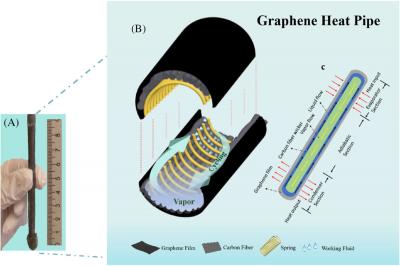Researchers at Sweden-based Chalmers University of Technology, in collaboration with researchers in China and Italy, have found that graphene-based heat pipes can help solve the problems of cooling electronics and power systems used in avionics, data centers, and other power electronics.
 A) Image of a real GHP; B) schematic designing of the GHP; C) working principle of the GHP
A) Image of a real GHP; B) schematic designing of the GHP; C) working principle of the GHP
Electronics and data centers need to be efficiently cooled and rid of excess heat in order to function properly. Currently, heat pipes are usually made of copper, aluminum or their alloys. Due to the relatively high density and limited heat transmission capacity of these materials, heat pipes are facing severe challenges in future power devices and data centers.
The graphene-enhanced heat pipe exhibits a specific thermal transfer coefficient which is about 3.5 times better than that of copper-based heat pipe. The new findings pave the way for using graphene-enhanced heat pipes in lightweight and large capacity cooling applications, as required in many applications such as avionics, automotive electronics, laptop computers, handsets, data centers and aerospace electronics.
The graphene-enhanced heat pipes are made of high thermal conductivity graphene assembled films assisted with carbon fiber wicker enhanced inner surfaces. The researchers tested pipes of 6mm outer diameter and 150mm length. They show great advantages and potential for cooling of a variety of electronics and power systems, especially where low weight and high corrosion resistance are required.
"The condenser section, the cold part of the graphene-enhanced heat pipe, can be substituted by a heat sink or a fan to make the cooling even more efficient when applied in a real case," explains Ya Liu, PhD Student at the Electronics Materials and Systems Laboratory at Chalmers.
The new study is based on a collaboration between researchers from Chalmers University of Technology, Fudan University, Shanghai University, China, SHT Smart High-Tech AB, Sweden and Marche Polytechnic University, Italy.

